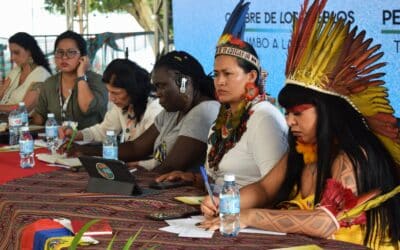(cross-posted from Focus on the Global South)
Since the beginning there was almost no expectations on the 19th session of the Conference of the Parties (COP19) of the United Nations Framework Convention on Climate Change (UNFCCC) in Warsaw, Poland; held November 11 to 23. Based on previous COPS, from Copenhagen until now, the signs had not been encouraging. Instead of moving forward, the talks have been moving backwards, even dismantling whatever weak climate regime that existed. Moving from “commitments” to only “pledges” for emissions reductions, and softening and shrinking even more the Kyoto Protocol, in COP19 historical emitters like Japan have announced that instead of reducing by 25 percent their emissions they will increase them by three percent by the year 2020 based on their levels of CO2 emissions in 1990. The list of rich countries that have moved out of the Second Commitment period of the Kyoto Protocol now includes Canada, Australia, Russia, and Japan.
The gap between what science and nature are telling us—through repeated and increasingly stronger storms, droughts, out-of-season weather phenomenon—and the ambition, commitments, and implementation under the UNFCCC is widening. The latest, and so far the strongest typhoon that visited the Philippines, is one more messenger. As argued by Philippine Climate Chief Negotiator Lucillle Sering, “it may be the Philippines this year, but it could be your country next.”
Weeks before the talks started, civil society groups already called COP19 the “Corporate COP.” The host country did not even find it peculiar at the least or distasteful, at worst, to hold the International Conference on Coal in a nearby conference venue around the same period as the climate talks. Coal is one of the primary causes of greenhouse gasses that cause climate change and no matter how much spin is done to present the possibility of producing “clean coal,” coal is coal–it will not be clean.
This was supposed to be a “Finance COP” but there were no real commitments to guarantee the US$100 billion as promised by developed countries. They even reiterated that that amount should include contributions from the speculative carbon markets and the private sector. In relation to Loss and Damage that is supposed to be a mechanism to compensate developing countries affected by climate change, the final outcome is weak.
Where do we need to be?
The goal should be to have annual global emissions of 38 Gt of CO2e by 2020 to be on a pathway towards limiting the increase in temperature by 1.5ºC. With the UNFCCC negotiations, there will be emissions of 57 GT of CO2e by 2020, only 1 Gt of CO2e less than business as usual. The new agreement that is supposed to be enforced in 2020 will be very weak if it is based on voluntary pledges as the US wants. Then it will be too late when we are already on a pathway to 4ºC or higher. Scientist are saying that the peaking year of global emissions should be in 2014, but until now no one knows how and when that will happen.
We are living in climate emergency, and therefore all countries should have binding commitments applying the principle of CBDR (Common But Differentiated Responsibility). The US, Europe, Japan, Canada, Russia, and other historical emitters should do emission reductions of 50 percent until 2020 and emerging countries like China, Brazil, India, and South Africa should also establish their peaking years to reach the target of 38 Gt of CO2e by 2020. Developing countries should follow a different path of “development” than historical emitters, redistributing in an equitable way the consumption of energy and avoid overconsumption and waste. The right to development cannot be used to pollute and enrich elites while the rest is submerged in poverty and dust.
Peoples’ power
COP19 was such a big farce that civil society groups walked out of the negotiations. There was nothing that could be done substantially inside the climate talks and it would be unsustainable to keep legitimizing the road to global burning for corporate interests.
This walkout should now serve as a wakeup call. National and global climate policies will change only when strong social movements embrace the fight for justice—across countries, across continents, and along economic, political, and environmental dimensions. The fight must be about concrete goals such as shutting down coal mines, stopping pipeline construction, halting fracking projects, imposing carbon taxes, banning GMOs, stopping free trade agreements, preserving indigenous lands, putting an end to land grabs, sinking carbon markets, and occupying financial speculative markets.
To address climate change, we need to link all kinds of initiatives: legal reforms and civil disobedience, hunger strikes and national consultations, massive protests and creative individual actions, consumers’ actions and boycotts, occupation of banks and road blockages, political pressure, and replication of good practices. We cannot lose energy in sectarian debates. The goal is to always try to go further from the original target, promoting broader and stronger forms of organization and mobilizations of workers, peasants, indigenous, women, youth, faith communities, migrants, intellectuals, artists, human right activists.
The madness in climate talks and the corporate interests behind them can only be stopped through peoples’ power.
November 25, 2013




